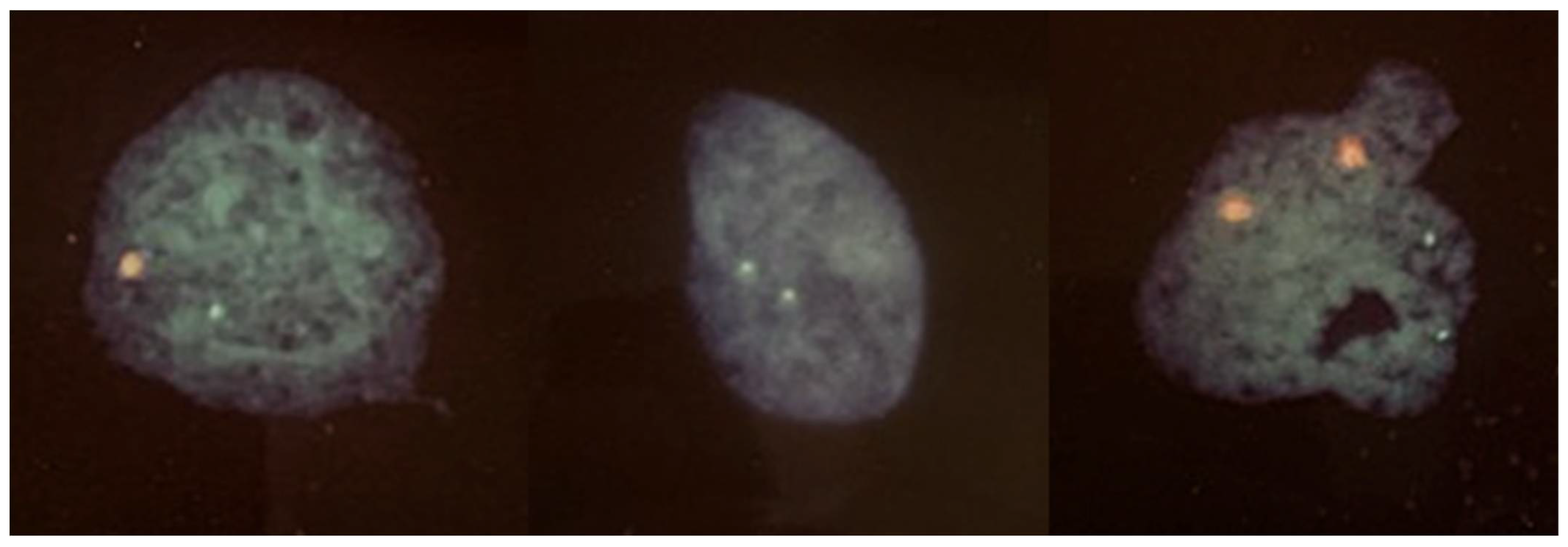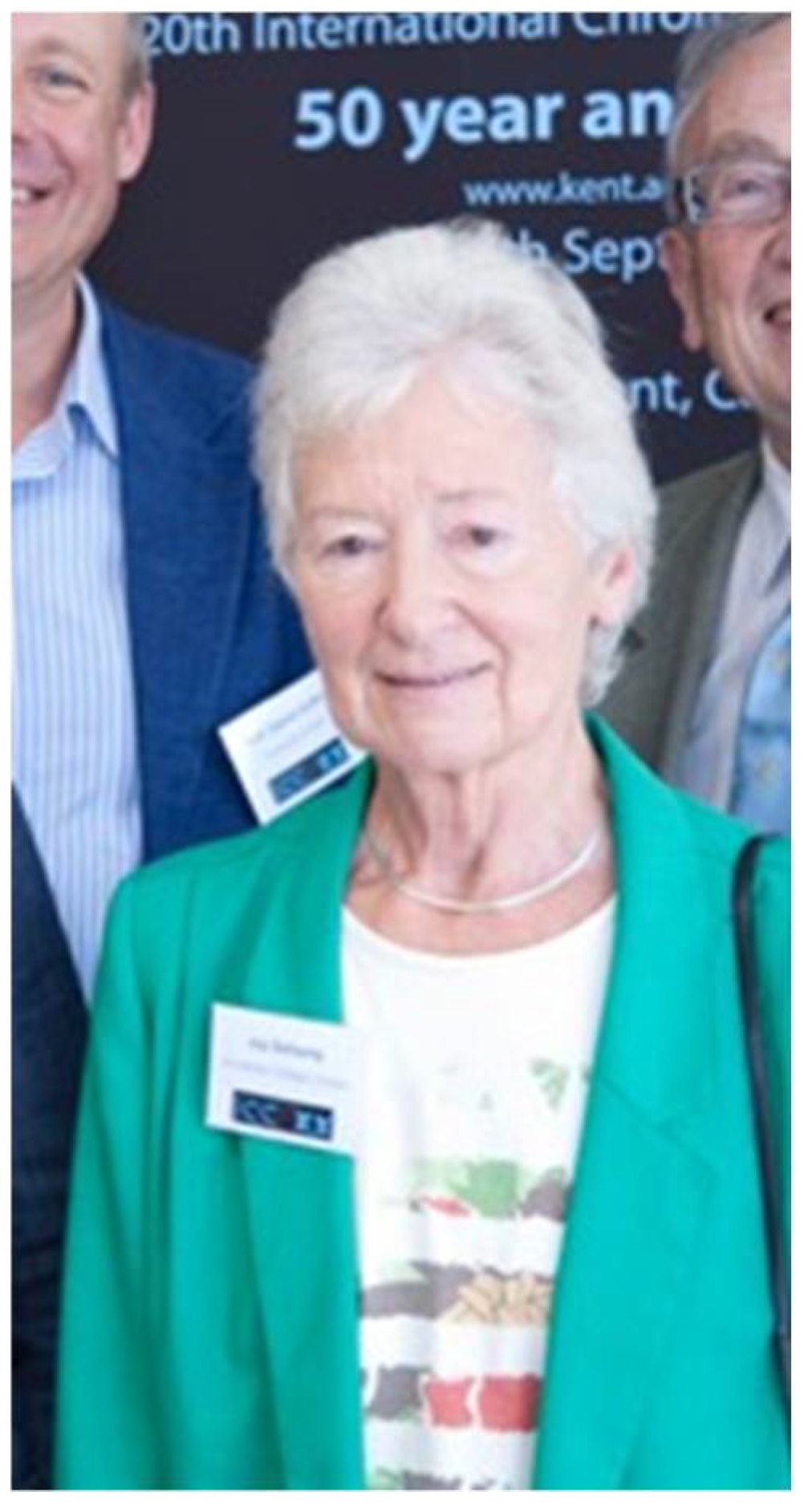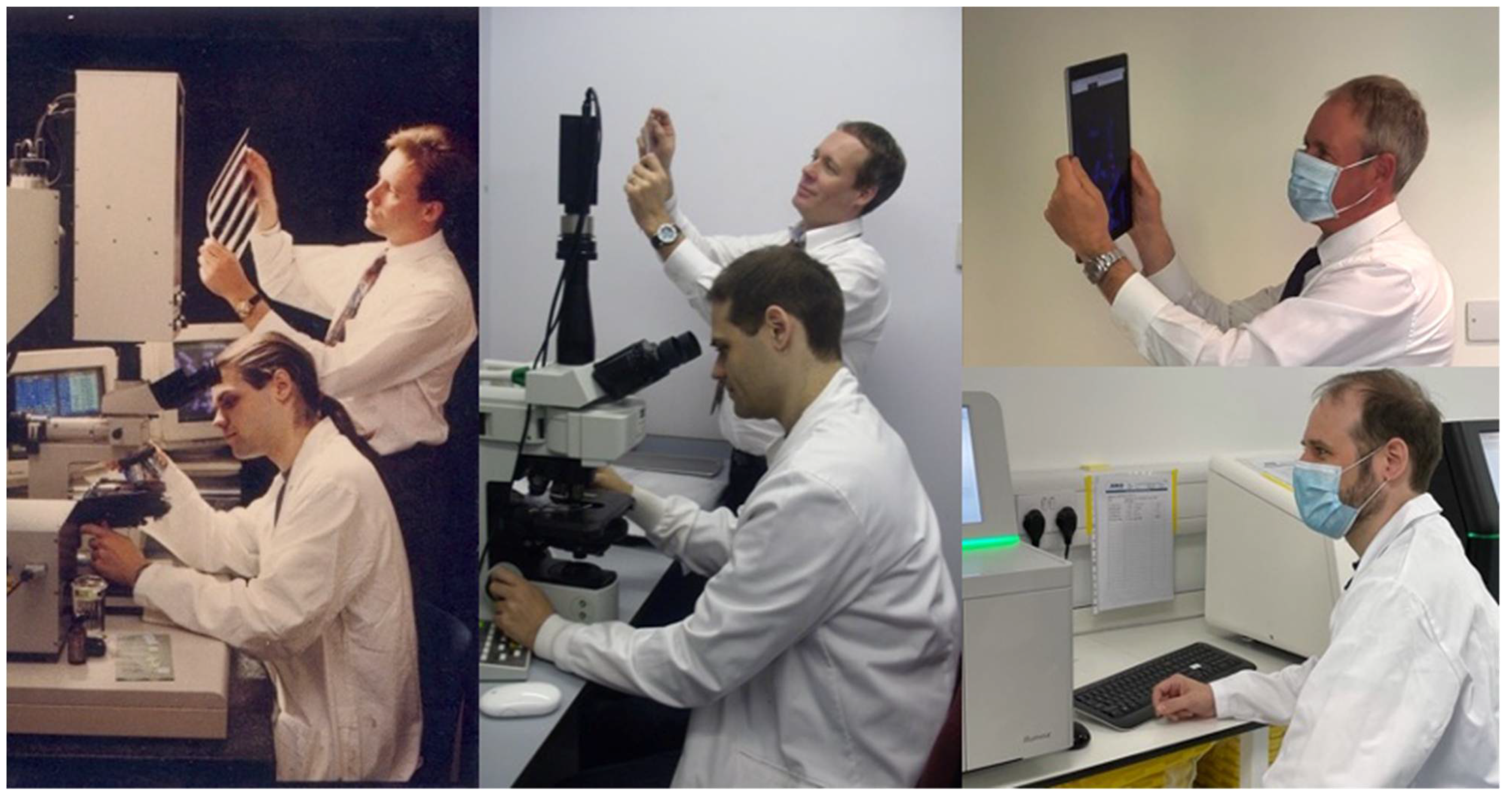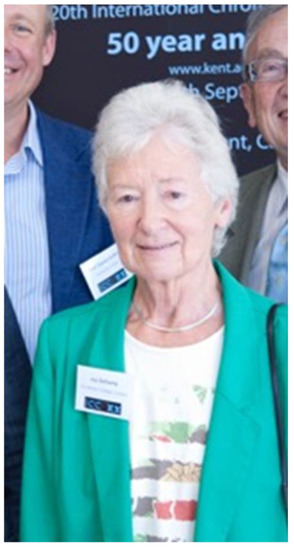Your browser does not fully support modern features. Please upgrade for a smoother experience.

Submitted Successfully!
Thank you for your contribution! You can also upload a video entry or images related to this topic.
For video creation, please contact our Academic Video Service.
| Version | Summary | Created by | Modification | Content Size | Created at | Operation |
|---|---|---|---|---|---|---|
| 1 | Darren Griffin | -- | 1664 | 2022-08-18 02:45:23 | | | |
| 2 | Amina Yu | Meta information modification | 1724 | 2022-08-18 03:25:01 | | | | |
| 3 | Amina Yu | Meta information modification | 1724 | 2022-08-18 03:26:23 | | |
Video Upload Options
We provide professional Academic Video Service to translate complex research into visually appealing presentations. Would you like to try it?
Cite
If you have any further questions, please contact Encyclopedia Editorial Office.
Griffin, D.K. Joy Delhanty. Encyclopedia. Available online: https://encyclopedia.pub/entry/26256 (accessed on 13 January 2026).
Griffin DK. Joy Delhanty. Encyclopedia. Available at: https://encyclopedia.pub/entry/26256. Accessed January 13, 2026.
Griffin, Darren K.. "Joy Delhanty" Encyclopedia, https://encyclopedia.pub/entry/26256 (accessed January 13, 2026).
Griffin, D.K. (2022, August 18). Joy Delhanty. In Encyclopedia. https://encyclopedia.pub/entry/26256
Griffin, Darren K.. "Joy Delhanty." Encyclopedia. Web. 18 August, 2022.
Copy Citation
PGD
red-green-blue” approach
cytogenetics
1. Brief Introduction
Joy Delhanty was a world leading cytogeneticist who stayed at University College London all her working life. Gaining her PhD under the supervision of Lionel Penrose in 1962 she made seminal contributions to the fields of Preimplantation Genetic Testing and cancer genomics.
2. Story about Notable Contributions
“Did it work?”
11 February 1991: With an enthusiasm and energy that might have surprised those that did not know her well, Joy flew around the door of the microscope room of University College London’s (UCL) Galton Lab with a big smile.
I remember the date clearly, as it was my birthday. The challenge had been to try and get a clinically robust preimplantation genetic diagnosis (PGD) protocol (to determine sex in a single cell) effective and reproducible in eight (rather than the usual 24) hours.
It had worked, and it had worked well.
An eight hour time-frame was essential, in accordance with the then “window of diagnosis” for PGD—to return the result within one working day so that the embryo could be transferred in the same menstrual cycle as the egg collection. The background to all this was that the much-fanfared, Nature-published PCR-sexing protocol for the world’s first PGD [1] just did not work at all well. Trying to amplify a Y chromosome DNA repeat, and then rely on visualising a band in an agarose gel to tell whether a cell was male or female was (with the benefit of that exact science that is hindsight) not the best of ideas. As Joy knew well, sometimes PCR just does not function (even today) but especially so in the late 1980s, when trying to place a single cell in a regular Eppendorf tube using a home-made glass pipette. False negatives were inevitable and frequent. Similarly, if any male was within 50 miles of the lab (I exaggerate), contamination (a false positive) was equally likely. Joy’s concept had been to carefully splat a single embryonic nucleus on to a glass slide and then use FISH (fluorescence in situ hybridisation) with X- and Y-specific probes in different colours to visualise the cells and chromosomes directly [2]. Using a Y-chromosome probe alone [3] had a similar problem to that of the PCR approach (too many false negatives). However, using the X chromosome alone [3] we actually made a new discovery. We serendipitously found that the phenomenon of mosaicism (some normal and some abnormal cells in an embryo) was commonplace in humans; the scientific community has been discussing it ever since. Nonetheless, we often had false positive “XX” cells (probably tetraploid male) and that would not suffice as a diagnostic test. Joy’s “red-green-blue” approach (Figure 1), however, not only visualised the cell directly, not only had inherent, independent confirmation (X and Y chromosomes separately) but also detected sex chromosome abnormalities at the same time. There are more up-to-date protocols these days of course, but, if all you wanted to do was sex a single cell, this protocol could still be used today, such is its robustness [4][5][6]. The protocol and, more specifically, its interpretation, was archetypal Delhanty—straightforward, visual, unequivocal and direct.

Figure 1. The original cytogenetic PGD cases. Male nucleus (red (Y chromosome), green (X chromosome) and blue (whole nucleus) (left). Female nucleus (two X chromosomes) (middle), and one of the first chromosome abnormalities identified in human embryos—XXYY (probably tetraploid) (right).
Robert Winston was on the phone the following day and, by the end of the week, we were running clinical cases. The rest is history. Alan Handyside would biopsy the embryos early in the morning at the Hammersmith Hospital, Leeanda Wilton would have travelled there to lay the nuclei down on glass slides and then Dagan Wells and I would take the slides back to UCL for FISH and microscopy. No result left the lab until it had received the most careful and intense scrutiny from Joy and then a faxed report (remember those?) was sent back to the Hammersmith to inform selective embryo transfer. In point of fact, FISH might have been the original PGD protocol were it not for the fact that Joy was meticulous in her approach. The Y chromosome FISH protocol was equally as good as the new PCR (less prone to false positives in fact) but not nearly as “whizz-bang” and, hey, cytogenetics was not very trendy in these days. Joy, the “true blue” cytogeneticist, (for image of her, see Figure 2) was ultimately proved right, however, and, as a result, we treated patients with the first ever cytogenetic PGD. Many families at risk of transmitting sex-linked disorders subsequently benefitted. The BMJ picked it up, as did BBC news and we were all on the TV. Joy was quite the publicist when she needed to be.

Figure 2. Joy as an invited speaker at the International Chromosome Conference held in Canterbury in 2014.
It was often said that “Joy” was perhaps not the most appropriate name for someone who was so apparently serious, so considered and so very, very quiet. This is an unfair criticism in many ways. Joy was deep, there is no doubt. Silences between the sentences of a conversation were commonplace and, when on the phone, could be quite disconcerting. Nevertheless, that was Joy, she was just thinking and considering her next response; she did not waste words. On the other hand, she was clearly passionate about her science, would fiercely support her students and staff and she created an environment of discovery and learning, the like of which you do not always see in labs today. Fundamentally I remember the “joy” in Galton lab 208 that, thinking back now, was probably a direct result of her management methods. I remember the people that became lifelong friends and leaders in the field of PGD in their own right, including Dagan Wells, Sioban Sen Gupta, Alan Thornhill, Joyce Harper, to name but a few. I remember the silly “in” jokes (“this is a matter of honour!”—“get off my laaaand!”—“buckwheat”—“I must confess”). It would take too long to explain these here, but I would happily share with anyone the derivation of these strange phrases, perhaps over a drink. This was life in Joy’s lab. Joy was rarely demonstrative, but always managed to create a buzz around her, while looking on with some bemusement at the dynamic environment for which she was responsible, Figure 3).

Figure 3. Publicity shot of (Messrs, Doctors, then Professors) Darren Griffin and Dagan Wells in 1992 (left) then reimagined in 2008 (middle) and 2021 (right).
3. Implications for Sciences, Humanities
Children never appreciate how lucky they are (how can they, they have no frame of reference?), and the same applies to PhD students. But Joy let us make our own mistakes, picking up the pieces when necessary. She got us around the world (literally a circumnavigation in my case) to speak about our research at conferences. She got us published. I also felt the enormous pride of being asked back to UCL by her to be an external examiner both for MSc and PhDs. Such is her legacy, not only her academic “children” but also the “grandchildren” (students of her students)—a phrase that, by the way, she did not care for. There are even a few great grandchildren out there now.
There are many lessons that we, her students, learned from Joy, some of which I will paraphrase here. I would like to think that many of these would resonate with other fellow Delhanty trainees. In point of fact, Joy would probably cringe at my attempts to sensationalise them. She once described the first draft of my thesis introduction as “too sensationalist and journalese”—a trait she never quite managed to beat out of me. Nonetheless, here they are:
-
Just do it. There is no good research unless you get on with it.
-
Keep it simple, stupid. Joy was never comfortable speaking in public, given her inherent shyness. Overcoming this, however, her research talks were sublime, measured, clear and full of good science.
-
Take your opportunities. Science is not always linear, planned and structured. Most of us often had a couple of projects on the go at any one time and were encouraged to take the new opportunities that they presented.
-
Always give credit. There are few parts of academia that raise the hackles more than authorship and it is sometimes amazing, in hindsight, to realise how Joy would go out of her way to make sure that credit was properly attributed.
-
There is nothing more important than your team. She empowered us, she showed us the way and then she watched with pride as we spread our wings.
-
Be a teacher. Many of us had the opportunity to give lectures and teaching in her practical classes. We benefitted from it enormously.
-
Publish and publicise. We did, and many of us continue to do so. By all accounts, her very last words were “make sure you get this published.”
Joy was one of the original cytogeneticists. Starting in 1956, and staying loyal to UCL until the end, she entered the field just at the time that the first determination of the correct human chromosome number was uncovered. She described the first human triploids; a discovery that led to the realization that triploidy [7][8] is one of the leading causes of pregnancy loss, providing reassurance to many thousands of couples that suffer first-trimester miscarriage. She discovered that Down Syndrome could be inherited by means of a Robertsonian Translocation [9][10][11] and she has a whole body of work in the molecular cytogenetics and molecular biology of cancer, particularly colon cancer, where there are a number of “firsts” in her CV. Perhaps her greatest contribution is her body of seminal work that tells us that the human embryo is not quite as it appears in the textbooks. A uniformly diploid number of 46 chromosomes in each and every cell is not the norm. Like Joy herself, early developing humans are complex, fluid and dynamic. Yes, dynamic, not in an overt way, and not a word normally associated with Joy. But dynamic nonetheless.
Further Reading
In this part, we encourage you to list the link of papers wrote by the character, or published reviews/articles about his/her academic contributions.
Edit
References
- Griffin, D.K.; Wilton, L.J.; Handyside, A.H.; Winston, R.M.L.; Delhanty, J.D.A. Dual fluorescent in situ hybridisation for simultaneous detection of X and Y chromosome-specific probes for the sexing of human preimplantation embryonic nuclei. Hum. Genet. 1992, 89, 18–22.
- Griffin, D.K.; Handyside, A.H.; Penketh, R.J.A.; Winston, R.M.L.; Delhanty, J.D.A. Fluorescent in-situ hybridisation to interphase nuclei of human preimplantation embryos with X and Y specific probes. Hum. Reprod. 1991, 6, 101–105.
- Griffin, D.K.; Wilton, L.J.; Handyside, A.H.; Atkinson, G.H.G.; Winston, R.M.L.; Delhanty, J.D.A. Diagnosis of sex in preimplantation embryos by fluorescent in-situ hybridisation. Br. Med. J. 1993, 306, 1382.
- Griffin, D.K.; Handyside, A.H.; Harper, J.C.; Wilton, L.J.; Atkinson, G.H.G.; Sousis, I.; Wells, D.; Ballsackz, B.J.; Kontogianni, E.H.; Tarin, J.; et al. Clinical experience with preimplantation diagnosis of sex by dual fluorescent in-situ hybridisation. J. Assist. Reprod. Genet. 1994, 11, 132–143.
- Delhanty, J.D.A.; Griffin, D.K.; Handyside, A.H.; Harper, J.; Atkinson, G.H.G.; Pieters, M.H.E.C.; Winston, R.M.L. Detection of aneuploidy and chromosomal mosaicism in human embryos during preimplantation sex determination by fluorescent in situ hybridisation, (FISH). Hum. Mol. Genet. 1993, 2, 1183–1185.
- Delhanty, J.D.; Ellis, J.R.; Rowley, P.T. Triploid cells in a human embryo. Lancet 1961, 1, 1286.
- Penrose, L.; Delhanty, J. Triploid cell cultures from a macerated foetus. Lancet 1961, 277, 1261–1262.
- Penrose, L.S.; Ellis, J.R.; Delhanty, J.D. Chromosomal translocations in mongolism and in normal relatives. Lancet 1960, 276, 409–410.
- Penrose, L.S.; Delhanty, J.D.A. Familial Langdon Down anomaly with chromosomal fusion. Ann. Hum. Genet. 1962, 25, 243–252.
- Delhanty, J.D.A.; Shapiro, A. An unusual acrocentric found in a case of idiocy with microphthalmia. J. Intellect. Disabil. Res. 1962, 6, 38–40.
- Handyside, A.H.; Kontogianni, E.H.; Hardy, K.; Winston, R.M.L. Pregnancies from biopsied human preimplantation embryos sexed by Y-specific DNA amplification. Nature 1990, 344, 768–770.
More

Name:
Joy Delhanty
Born:
Aug 1940
Died:
Dec 2021
Birth
Location: Unknown
Location: Unknown
Title:
original cytogeneticists
Affiliation:
University College London
Honor:
Unknown
Information
Subjects:
Cell Biology
Contributor
MDPI registered users' name will be linked to their SciProfiles pages. To register with us, please refer to https://encyclopedia.pub/register
:
View Times:
1.0K
Revisions:
3 times
(View History)
Update Date:
18 Aug 2022
Notice
You are not a member of the advisory board for this topic. If you want to update advisory board member profile, please contact office@encyclopedia.pub.
OK
Confirm
Only members of the Encyclopedia advisory board for this topic are allowed to note entries. Would you like to become an advisory board member of the Encyclopedia?
Yes
No
${ textCharacter }/${ maxCharacter }
Submit
Cancel
Back
Comments
${ item }
|
More
No more~
There is no comment~
${ textCharacter }/${ maxCharacter }
Submit
Cancel
${ selectedItem.replyTextCharacter }/${ selectedItem.replyMaxCharacter }
Submit
Cancel
Confirm
Are you sure to Delete?
Yes
No




